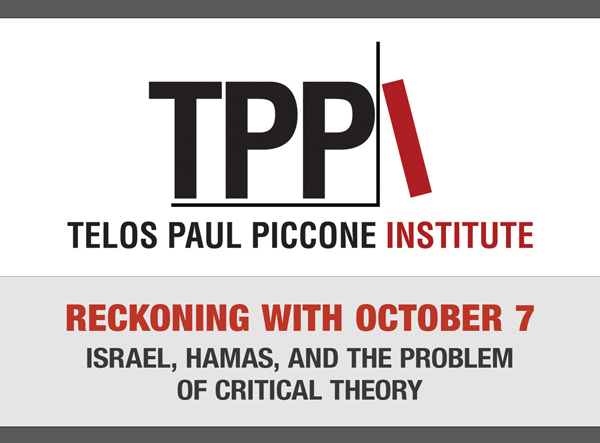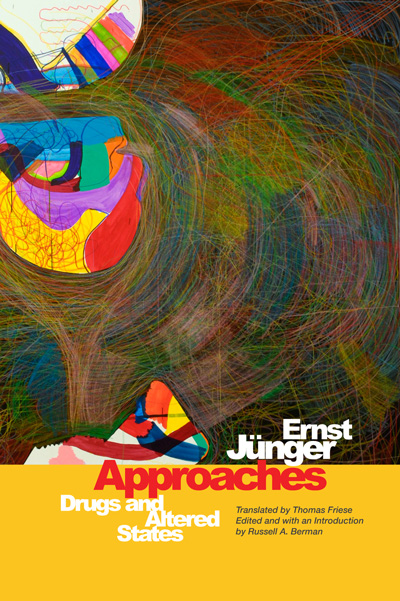 In this brief interview, Martin Cüppers refers to Islamic antisemitism in Germany as a “reimport.” That terse designation builds on his core thesis that during the 1930s Nazi Germany exported its particular brand of antisemitism, with all its uncompromising viciousness, to the Arab world, where it spread and festered and eventually came to define the Arab–Israeli conflict. With the considerable immigration from the Arab world into Germany, especially after 2015, this same Nazi legacy has returned to Europe. The Federal Republic of Germany, which made serious efforts to develop a memory culture and to face up to the German culpability for the Shoah, had in effect opened its doors to carriers of some of the same Nazi values that it had done its best to overcome. The refugees from the Arab world were Germany’s own “return of the repressed.”
In this brief interview, Martin Cüppers refers to Islamic antisemitism in Germany as a “reimport.” That terse designation builds on his core thesis that during the 1930s Nazi Germany exported its particular brand of antisemitism, with all its uncompromising viciousness, to the Arab world, where it spread and festered and eventually came to define the Arab–Israeli conflict. With the considerable immigration from the Arab world into Germany, especially after 2015, this same Nazi legacy has returned to Europe. The Federal Republic of Germany, which made serious efforts to develop a memory culture and to face up to the German culpability for the Shoah, had in effect opened its doors to carriers of some of the same Nazi values that it had done its best to overcome. The refugees from the Arab world were Germany’s own “return of the repressed.”
Cüppers’s argument about Nazi ideology as a source for Palestinian and more broadly Arab antisemitism is part of a larger body of scholarship that includes the publications by Jeffrey Herf, Matthias Küntzel, and Elham Manea in particular. Thanks to this research, the claim has become incontrovertible that Nazi Germany played a significant role in shaping the ideology of the Arab–Israeli conflict in ways that continue today and that explain the unique brutality of the October 7 Hamas attacks as well as the aspiration for a massive elimination of Jews from the region. It is exactly that which finds expression in the frequent call for Arab Palestine––فلسطين عربية—which means Arabs only, and no one else (one looks in vain in the founding documents of the PLO or Hamas for any commitment to minority rights).
The concern with a “reimport” of antisemitism is indicative of growing claims about a cultural incompatibility between contemporary Europe and the growing numbers of migrants and asylum seekers, especially from the Muslim world. This is of course a reprise of early debates about values differences between the West and the Muslim world that had erupted, for example, around the Rushdie affair in 1988 and again in response to Pope Benedict’s Regensburg Address in 2006. The scope of the explicitly Islamist and pro-Hamas demonstrations in European capitals in the wake of the October 7 massacre has elicited a profound transformation of public discussion. The optimistic Germany of 2015, when a “culture of welcome” seemed to flourish and Chancellor Merkel encouraged her compatriots that they could handle the challenges with her “Wir schaffen es” promises now belongs to a bygone era.
In the wake of the anti-Israel demonstrations with extensive antisemitic excesses during October, Vice-Chancellor Robert Habeck gave an address on November 9, the somber anniversary of Kristallnacht, expressing Germany’s commitment to Israel and threatening the deportation of refugees who celebrate Hamas or burn Israeli flags. By emphasizing that the demonstrations often had an Islamist character—i.e., they not only have been expressions of political opposition but have displayed explicit Islamist advocacy—he named a cultural gap between German expectations of immigrant integration and the self-understanding of some members of the immigrant communities embedded in the distinction and non-integration of their parallel societies. While Habeck spoke with the sincere concern of a German burdened by a national past, it would be foolish to ignore how his anxieties—no matter how progressive this leader of the Green Party may be—are hardly distant from the anti-immigrant wave that is sweeping Europe, and the United States as well. Witness Geert Wilders’s extraordinary victory in the Dutch elections and the growing strength of the Le Pen party in France and the AfD in Germany. Italian Prime Minister Giorgia Meloni made the argument about cultural difference as clearly as possible with her reference to Sharia law in connection with immigration.
There is interestingly a certain analytic tension between Cüppers’s argument about a Nazi genealogy of Arab antisemitism and the broader cultural arguments about Islam. To the extent one views the problem as a Nazi legacy, then one obtains a powerfully pejorative label with which to denounce the radical opposition to Israel and to Jews: the antisemitic demonstrators are in that case basically neo-Nazis or, less polemically, inheriting a hostility to Jews that was minted by the Nazis and transmitted to Middle East radicals like the Muslim Brotherhood. In that case, Germany is indeed facing a “reimport,” and one would have to conclude that the core of the problem is ultimately a European one, no matter how it has traveled through the Middle East, only to return via the refugees. However this account stands at odds with alternative views that point to anti-Judaic elements inherent in Muslim culture, as ancient as passages in Islamic sacred texts, which arguably include both philosemitic and antisemitic formulations. Obviously this second approach does not make the comprehensive claim that all of Islam, its expansive body of teachings across multiple schools and denominations, is centrally antisemitic—that is not a tenable claim at all—but it does recognize the presence of anti-Judaic elements. Part of the ideological intervention of the Nazis in the Middle East, as Matthias Küntzel has shown, involved mining the Islamic tradition for sometimes overlooked antisemitic elements and moving them to the forefront. The two different arguments—Nazi ideology imported into the Middle East as opposed to indigenous and originally Islamic elements—are not incompatible. They point to two different sources for an antisemitism that is manifesting itself prominently in the wake of October 7, in the West as much as in the Middle East.
These considerations bring us to the broader question as to whether anti-Zionism is likely to be antisemitic, and not merely in Germany with its particular national past. At a basic definitional level, if one understands Zionism as the advocacy for a state for Jews, a consistent anarchist position, opposed to all states, might genuinely be anti-Zionist without being antisemitic. But that anarchist anti-Zionist would also have to oppose a Palestinian state, a Syrian state, a German state, etc., in other words, a no-state solution. Obviously that ad absurdum approach has nothing at all to do with the character of contemporary debates.
In the United States, where Christian support for Israel is numerically much larger than the small Jewish community, there has been, to my knowledge, never an anti-Israel demonstration outside of a church whose congregation supports Israel, while there are regular reports of protests, graffiti, threats, or destruction of property at Jewish sites, most recently attacks on public menorah displays here and here, i.e., specifically Jewish, not Israeli, symbols. In such cases it is impossible not to see the obvious, that anti-Zionist opposition to Israel has turned into attacks on Jewish sites and thereby revealed its own innate antisemitic character. Just because an event has an anti-Zionist character hardly precludes it from also being anti-Jewish and therefore antisemitic. The many attacks against Jewish students on campuses in the name of anti-Zionism demonstrate how, in practice, it is impossible to pretend that antisemitism is not also in play, as much as idealistic progressives might pretend it is otherwise.
This increasingly unmistakable congruence of antisemitism and the reality of today’s anti-Zionism is particularly evident in the chants of demonstrators. The songs they sing and the slogans they shout are surely plausible indicators of their intentions and motivations. In public discussion, much attention has been paid to the implication of the slogan “from the river to the sea,” quite clearly a claim for all the territory between the Jordan River and the Mediterranean Sea and therefore all of the State of Israel, not only the West Bank and Gaza. It clearly envisions the elimination of the Jewish state; to understand it otherwise requires an Orwellian suspension of logic. Apologists for the slogan try to argue that it projects an innocent program for a single, liberal democratic and free state; this outcome would indeed be remarkable since nothing of the sort exists elsewhere in the region. More telling however is the fact that the invocation of a “free Palestine” is regularly accompanied, in written texts, by the Arabic-language descriptor discussed above, فلسطين عربية, i.e., an Arab Palestine. Evidently the goal is the establishment of an exclusively Arab space between the river and the sea. Another name for that program is ethnic cleansing.
Documented examples of public sloganeering give further texture to the contemporary anti-Zionist movement and its antisemitic character. For example, at a demonstration in London, some participants began to chant a rhyme that invokes the battle in 628 CE in which Mohamed vanquished the Jewish tribe living near the oasis of Kheybar outside of the Medina in the Arabian desert. That ancient history itself is less relevant than the framing of contemporary opposition to Zionism in the terms of an original Muslim war against Jews: خيبر خيبر يا يهود، جيش محمد سيعو or “Kheybar, Kheybar, oh Jew, the army of Mohammed will return.” There is surely no doubt that the enemy here is “the Jew,” not the Zionist state, and the intent can therefore be reasonably described as antisemitic. Nor was this chanting a single incident; the slogan made its way onto demonstrator-chic apparel as well as seen here. Still, at least in this clip it appears that other demonstrators may have tried to suppress this antisemitic rhetoric.
A different kind of chant in the Paris metro from early November lacked the same historical awareness of the Kheybar verse, but it distinguished itself with a noteworthy degree of vulgarity, combining a promise to subject mothers and grandmothers to sexual assault with a direct self-identification with Nazis: on est des nazis et fières. Wittingly or not, here the display of public anti-Zionism appears to endorse the rape warfare that Hamas undertook on October 7 while simultaneously corroborating the claim of an epigonic Nazism, as proposed by Cüppers, Herf, and Küntzel.
It is likely that these two pieces of textual evidence, the Kheybar appeal in London and the rape song in Paris, will be brushed off by those apologists who want to argue that anti-Zionism has, by definition, nothing to do with antisemitism ever. After all these are just two short texts associated with tiny groups; yet it is often the case that the true character of events becomes most evident in microstructures such as these. So to close out the argument with a different sort of testimony, I point to a large demonstration in Ramallah, the headquarters of the Palestinian Authority, which is sometimes viewed as the political alternative to Hamas. In this clip we witness a very considerable crowd, marching in the wake of the October 7 attack (“shortly before” the posting dated as of October 27). What are they shouting? There are two parts. In the first, a leader cries out a verse which the crowd then repeats. This happens four times, and the full text reads:
“.يلي معك بارودة ومخبيها للأعراس .. يا بطخ اليهودي يا بتعطيها لحماس”
An English rendering might be: “Whoever has a rifle that you have been saving for a wedding [a reference to the custom of shooting off firearms as part of a celebration], go kill a Jew or give it [the rifle] to Hamas.” So here too—as in London and in Paris—there is no doubt about the identity of the enemy. There is an alternative Arabic term for “Israeli,” and another for “Zionist,” but the name of the target here is explicitly “the Jew.” Anti-Zionism in practice turns out to be indistinguishable from antisemitism. To this one can add that the verse displays a certain crude eroticization of murder, given the association of the rifle with a wedding—grossly macabre in the wake of the October 7 rapes—and the explicit solidarity with Hamas, what’s more in the center of power of the Palestinian Authority.
In this case, the chanting continues however with another slogan (at about twenty seconds of the clip): الشعب يريد كتائب القسام or in English “the people want the al-Qassem brigade,” i.e., the fighting force of Hamas, established in 1991, specifically to carry out terrorist attacks and abductions inside Israel. In case there was any doubt about public opinion in Ramallah, the verse conveys the claim of popular support (“the people want”) for Hamas as a military force. Yet there is also an implicit intertextuality that imbues the text and the enthusiasm with which it was shouted out with a sinister political resonance. The Arabic language text sounds like a rhymed echo of another slogan: الشعب يريد سقوط النظام or “the people want the fall of the regime,” the appeal during the Arab Spring of 2011, in Syria, Egypt, and Tunisia, for an end to the dictatorships and the establishment of popular democracy, the revolutionary program that generally failed. So in this Ramallah rendition of 2023, the 2011 call for “the fall of the regime,” “sukut annitham,” is replaced by a rhyming call for the Al-Qassem Brigade, “kataib al-Qassam”. The hope for democracy in the Arab spring turns into the marchers’ pursuit of an opportunity to kill Jews. Antisemitism is therefore not only a murderous war against the Jews; it is also the program that displaces and silences the erstwhile democratic aspirations to end dictatorships. The dream of defeating Netanyahu is a way to keep Assad in power in the ideological shell game that is played out in the vocabulary of the Ramallah chant.
These various articulations of anti-Zionism, as well as Cüppers’s tracing of the long shadow of Nazi exterminationism, are of course only part of the much larger and complex political, military, and ideological conflict that is underway in the Middle East. Nonetheless it should be clear that anti-Zionism, as it really exists today, is extensively implicated in antisemitism. The claims that there is no antisemitism at play in this really existing anti-Zionism are either profoundly uninformed or intentionally deceptive.





The assertion that Jew hate was imported to the Arab world only to be returned with refugees to Germany is at odds with the historical data showing the Mufti palling around with Hitler during the war. Is it as likely that the Mufti gave Hitler the idea to engage in wholesale extermination?
Protestant Kaiser Wilhelm II who went before the Sultan on Herzl’s behalf is also the creator of the German -Ottoman Alliance. Wilhelm II primed Muslin resistance to British Expansionism. Hitler adopted these policies. The Grand Mufti understood foreign Jews a threat to the nonjewish communities of Palestine 20 years before sitting down with Hitler.
In light of so much evidence and common sense (Israel is where half the Jews live, so at best anti-Zionists are only 50% anti-Semitic?), anyone who claims contemporary anti-Semitism and anti-Zionism are not, manifestly, of a piece is either speaking in bad faith, seeking to muddy the waters, knowingly or unknowingly, or lying. It’s like saying Arabs can’t be anti-Semites because they too, after all, are “Semites” themselves. Albeit, unlike the author of this lucid article, not many in the scrum have his command of Arabic, so maybe that too is part of it. Anti-Zionism is anti-Semitism, as some of us have been saying for years. Israel is the center of Jewish life today, a Hebrew speaking republic, a Jewish world unlike any other. To oppose it as illegitimate per se—short of the principled anarchist’s position, that equally opposes a Palestinian state, a German one, or an American one, etc.—is to convict oneself of double-standards applied to Jews, a classic trope dear to anti-Semites everywhere. Let’s be real, if Germany still exists after what it did, then there is literally nothing an established UN member state can do to lose its status as sovereign within a territory. Or, if you actually think that Germany, Israel, and other states must be done away with to bring about a utopia free of all state power, then can we at least go in alphabetical order?
Thanks, Russell, for this insightful, linguistically-informed essay. Further evidence appears in a news story in today’s ‘New York Times’ on the Iran-aligned Houthis of Yemen: “For decades, the Houthis had anchored their ideology on hostility toward the United States and Israel, and support for the Palestinian cause. ‘Death to America, death to Israel, a curse upon the Jews’ is part of the group’s slogan.” (Apparently they have a lengthy “slogan.”) Norty
I am surprised you dont deal with the real issues at stake. Jewish settlers in Palestine, like white settlers in 18/19thc US or Australia, were pushing out the local peoples. Systemic Arab resistance to this flood of settlers began after the Zionist Balfour declaration and has not abated since. Hamas is the latest group of anti-colonialists to take up arms against the zionist settler colonialists. In doing so it is repeating a pattern well established in other modern settler colonial states including of course South Africa where, unlike New Zealand or the US say, the colonised have been successful in taking control. The problem with your way of thinking in the end is that you believe it is all about Jews, but it is not. It is about Palestinians.